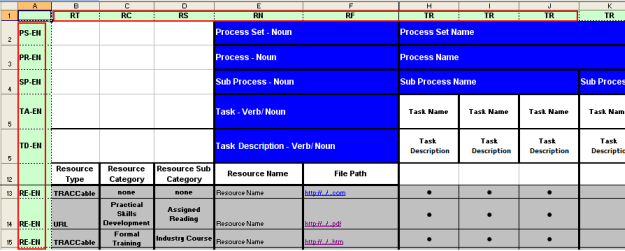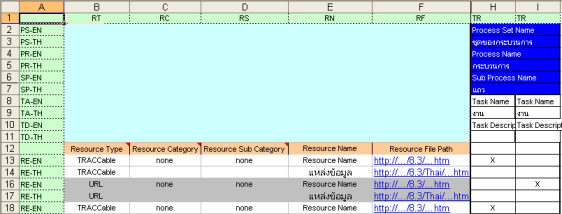|
|
|
|
This page explains the different procedures related to importing your spreadsheet. Before importing, you must configure your spreadsheet in a certain way using specific rules. So whether you start by using the provided spreadsheet and copy your fields in the correct locations or you add the required codes to an existing spreadsheet, these procedures consists of areas to watch for and not necessarily steps to follow.
To access a blank process model import spreadsheet:
Click here to access an XLS file containing the relevant Import Process Model Session Objects codes.
The File Download dialog appears. ![]()
Click Save. DO NOT click Open. If you do, the file will open in the Help window, with no way to save any changes you may wish to make.
The Save As dialog appears. ![]()
Navigate to a desired location.
(optional) Enter a new name for the Import Process Model Session Objects file.
Click Save.
Click Open.
The XLS file opens in Microsoft Excel. ![]()
Use the appropriate worksheet to begin entering your data. If you are entering an English only installation, delete the other worksheets. The same applies to using English/Thai installations and English/Chinese installations. Failure to delete the extra worksheets will result in errors during the import process.
To verify the current Resource Categories/Subcategories:
The Import Process Model Objects File Format page makes reference to the default Resource Categories/Subcategories. If you enter those referenced, and they have been changed in your database, this will result in errors during the import process. Check these values before starting the import.
Select Tools > System Options.
The System Options dialog appears. ![]()
Click the Task tab.
Click the Edit... button for Resource Categories and Resource Subcategories to verify the current values.
To Customize the spreadsheet to include Process Model Import codes:
Ensure that Row 1 and Column A consist of the codes discussed in the Import Process Model Objects File Format page.

Please Note: You must have rows PS-[language code], PR-[language code], SP-[language code], TA-[language code], and TD-[language code] in the same order as above, and they must all be present. Even if you are not entering all of these objects, their codes must be present.
Also, in the above graphic, rows 6-11 and column G, are hidden. They do not contain any codes and will, therefore, not be read by the import process.
In the Resource Type column, ensure that the values are either URL, TRACCable, or Course only. The import does not recognize any other resource type.
Where the resource is to be matched to a Task, put something (i.e., an "X") in the cell that is the intersection between the Resource name and the Task name.
(Multilingual installations) Under each of the first four rows, add another row that will be the equivalent object name in the other language.

Save the file with the .xls extension.
To Import the spreadsheet:
Select Maintenance > Batch Processing > Import Process Model.
The Import Process Model Session Objects dialog appears. ![]()
Click Browse.
A standard Open dialog appears.
Navigate to the import file, select it, and click Open.
The file path field is populated.
Choose what language you are using in your spreadsheet from the dropdown menu.
If you are using a spreadsheet with multiple languages, please read this note to learn which language should be chosen from the dropdown menu.
Click Import.
An Question dialog appears to confirm the start of the process.
Click Yes.
An import log appears within an Import dialog. At this point, you may wish to copy/paste the information into another document. This information will indicate how many records were successfully imported, how many were unsuccessfully imported, and where any problems occurred.
Click OK.
The Process Model is now imported into your system.
Additional Help:
Import Process Model Objects File Format
Interpret Import Process Model